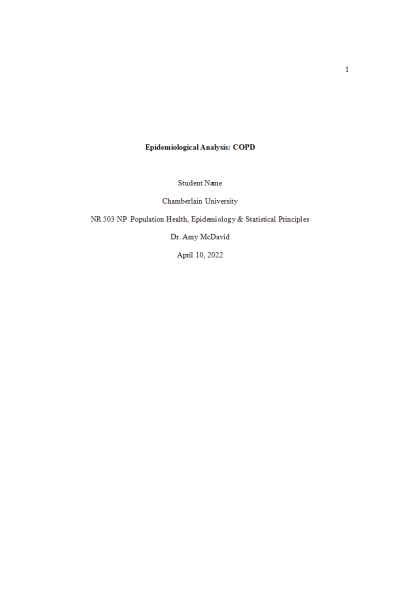NR 503 Week 6 Assignment; Epidemiological Analysis - COPD
-
$20.00
| Institution | NR 503 Population Health, Epidemiology & Statistical Principles |
| Contributor | Gonzale |
Epidemiological Analysis: COPD
NR 503 NP Population Health, Epidemiology & Statistical Principles
Epidemiological Analysis: COPD
Chronic Obstructive Pulmonary Disease (COPD) is a lower respiratory lung disease, and an obstruction of airflow in the lungs that make it hard to breath. It is a health problem that affects the breathing of an individual. According to the CDC, 2021, as of 2018, United States confirms that COPD is the fourth leading cause of death, with women at a higher incidence of mortality. Inhalation of tobacco products has been a key factor in COPD, along with other environmental exposures. In the United States, there were more than 15,000,000 people diagnosed with COPD, and more than 150,000 deaths in 2015 (Centers for Disease Control and Prevention [CDC], 2018). COPD hospitalization and readmission rates have a great burden on healthcare cost, and management of the disease. Those individual living with COPD, are at risk for depression as the progression of the disease debilitates their freedom, and independence.
Symptoms of COPD may vary from mild to even severe for others. This paper will look at the background and the significance of COPD, the current surveillance reports, and reporting methods on the health problem. The descriptive epidemiological analysis of COPD will be discussed, along with appropriate screening, diagnosing, and current guidelines on the public health problem. As a future nurse practitioner (NP), an appropriate plan of action for COPD integrated from evidence-based practice............................... Continue
| Instituition / Term | |
| Term | Year 2022 |
| Institution | NR 503 Population Health, Epidemiology & Statistical Principles |
| Contributor | Gonzale |
















































![NR 503 Week 8 Discussion; Health Policy and Ethics - Maryland Department of Health [MDH], 2017 NR 503 Week 8 Discussion; Health Policy and Ethics - Maryland Department of Health [MDH], 2017](https://www.gradesbooster.com/image/cache/catalog/3422-80x80.png)

























